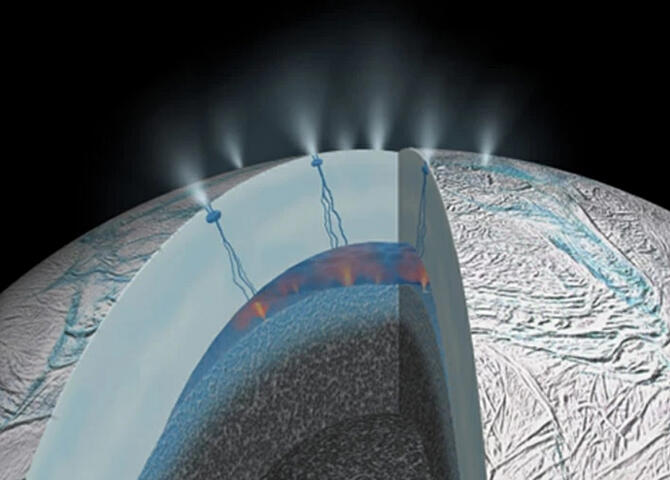A research group led by Professor Yasuhito Sekine, Director of the Earth-Life Science Institute at Tokyo Institute of Technology and Researcher Shuya Tan, currently a Young Research Fellow at the Institute for Extra-cutting-edge Science and Technology Avant-garde Research at the Japan Agency for Marine-Earth Science and Technology, along with Senior Scientist Takazo Shibuya at the Japan Agency for Marine-Earth Science and Technology, in collaboration with Professor Frank Postberg at Freie Universität Berlin, Germany, announced that phosphorus, an essential element for terrestrial life, is present in the oceans of Saturn's moon Enceladus at concentrations that are thousands to tens of thousands of times higher than those found in Earth's seawater. The research group determined that these high concentrations of phosphate are the result of a chemical reaction between rocks and high-carbonate, alkaline seawater.
These research findings are expected to contribute to understanding the origins of terrestrial life and serve as a guideline for future exploration missions. The results were published in the June 14th issue of the international scientific journal Nature.

Provided by NASA/JPL
The Saturn probe Cassini, developed by NASA, was launched in 1997 and arrived in the area of Saturn in 2004, it explored and provided new insights until 2017. Based on these observations, it was reported that Enceladus (one of Saturn's moons) possesses the three essential elements for the existence of life: liquid water, organic compounds, and energy.
Enceladus is a celestial body with a diameter of approximately 500 kilometers, consisting of a rocky core and a subsurface ocean beneath a thick covering of ice. Seawater from the subsurface ocean spews into space through cracks near the south pole of Enceladus. This seawater plume was analyzed by passing through it with a probe, which revealed that the subsurface ocean has properties similar to highly carbonated water, including a significant amount of carbon dioxide, with a temperature of 90℃ and pH levels ranging from 9 to 11.
In 2015, a Japanese research group led by Sekine reported the presence of submarine hydrothermal vents in the subsurface ocean of Enceladus. In addition, Postberg and other research groups from Europe and the United States conducted detailed compositional analysis of hundreds of particles captured by Cassini's Cosmic Dust Analyzer, including seawater particles that erupted from Enceladus.
Postberg and his colleagues discovered that these particles contained not only sodium salts but also high concentrations of phosphate. Of the 345 particles examined; 9 particles were found to contain phosphates.
Based on this proportion of the sampled particles that contained phosphates, the concentration of phosphate in Enceladus' seawater was estimated to be between 0.8 and 21 millimoles per kilogram. This suggests that the phosphate concentration in Enceladus' seawater is several hundred times higher than the 500 nanomoles per kilogram found in Earth's seawater. However, the cause of this extremely high concentration was previously unknown.
From this background Sekine's group conducted experiments based on previous studies. They observed the reaction between simulated Enceladus seawater solution (NaHCO3 + NH3) and a powdered carbonaceous chondrite (simulated rock core) similar to the rocks constituting the seafloor, under the thermal conditions (300 atmospheres, 150℃) found in Enceladus' subsurface ocean. It was found that the highly carbonated, alkaline seawater dissolves the phosphates contained in the rocks, leading to high phosphate concentration in the seawater.
This water environment is believed to be universally present in subsurface oceans of icy celestial bodies in the outer solar system, such as other moons of Saturn, Uranus, Neptune, and Pluto. If traces of life are found in these celestial bodies, there is a possibility that they might have similar chemical compositions to terrestrial life.
For terrestrial life, phosphorus plays a crucial role in fundamental processes, such as constituting DNA and phospholipids in cell membranes. However, phosphorus is scarce in the current water environments on Earth. Although phosphorus is present in rocks, it can only be utilized biologically when dissolved in water.
Current theory suggests that a phosphate- enriched water environment is essential for the emergence of life. However, it has remained unclear how such conditions would occur. This study demonstrated the actual process by which phosphate concentration occurs and confirmed that these conditions are present in extraterrestrial oceans.
It is believed that the early Earth had a thick atmosphere of carbon dioxide; combined with hydrothermal vents on the seafloor that ejected hot, alkaline water, this was thought to be an environment where high phosphate concentration could occur. The result of this study strongly supports this hypothesis.
Sekine stated, "This discovery suggests the possibility that life that is materially and chemically similar to life on Earth's, may exist universally in the outer solar system. We believe that this provides realistic observation targets for the next exploration of Enceladus."
This article has been translated by JST with permission from The Science News Ltd. (https://sci-news.co.jp/). Unauthorized reproduction of the article and photographs is prohibited.




